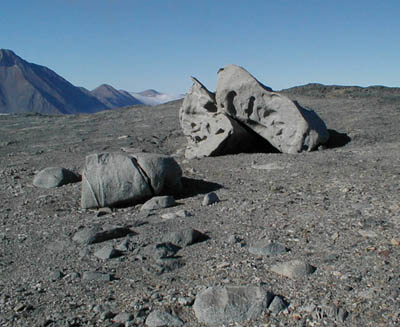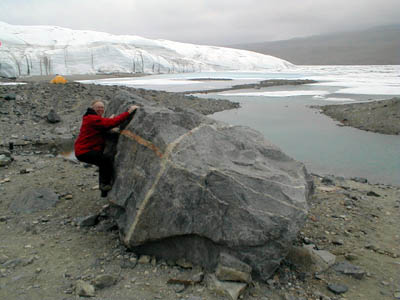
 http://www.exo.net/~pauld/antarctica/dryvalleys.html
http://www.exo.net/~pauld/antarctica/dryvalleys.html
Posted on 06/01/2006 2:26:58 PM PDT by PatrickHenry
Ancient mega-catastrophe paved way for the dinosaurs, spawned Australian continent.
Planetary scientists have found evidence of a meteor impact much larger and earlier than the one that killed the dinosaurs -- an impact that they believe caused the biggest mass extinction in Earth's history.
The 300-mile-wide crater lies hidden more than a mile beneath the East Antarctic Ice Sheet. And the gravity measurements that reveal its existence suggest that it could date back about 250 million years -- the time of the Permian-Triassic extinction, when almost all animal life on Earth died out.
Its size and location -- in the Wilkes Land region of East Antarctica, south of Australia -- also suggest that it could have begun the breakup of the Gondwana supercontinent by creating the tectonic rift that pushed Australia northward.
Scientists believe that the Permian-Triassic extinction paved the way for the dinosaurs to rise to prominence. The Wilkes Land crater is more than twice the size of the Chicxulub crater in the Yucatan peninsula, which marks the impact that may have ultimately killed the dinosaurs 65 million years ago. The Chicxulub meteor is thought to have been 6 miles wide, while the Wilkes Land meteor could have been up to 30 miles wide -- four or five times wider.
"This Wilkes Land impact is much bigger than the impact that killed the dinosaurs, and probably would have caused catastrophic damage at the time," said Ralph von Frese, a professor of geological sciences at Ohio State University.
He and Laramie Potts, a postdoctoral researcher in geological sciences, led the team that discovered the crater. They collaborated with other Ohio State and NASA scientists, as well as international partners from Russia and Korea. They reported their preliminary results in a recent poster session at the American Geophysical Union Joint Assembly meeting in Baltimore.
The scientists used gravity fluctuations measured by NASA's GRACE satellites to peer beneath Antarctica's icy surface, and found a 200-mile-wide plug of mantle material -- a mass concentration, or "mascon" in geological parlance -- that had risen up into the Earth's crust.
Mascons are the planetary equivalent of a bump on the head. They form where large objects slam into a planet's surface. Upon impact, the denser mantle layer bounces up into the overlying crust, which holds it in place beneath the crater.
When the scientists overlaid their gravity image with airborne radar images of the ground beneath the ice, they found the mascon perfectly centered inside a circular ridge some 300 miles wide -- a crater easily large enough to hold the state of Ohio.
Taken alone, the ridge structure wouldn't prove anything. But to von Frese, the addition of the mascon means "impact." Years of studying similar impacts on the moon have honed his ability to find them.
"If I saw this same mascon signal on the moon, I'd expect to see a crater around it," he said. "And when we looked at the ice-probing airborne radar, there it was."
"There are at least 20 impact craters this size or larger on the moon, so it is not surprising to find one here," he continued. "The active geology of the Earth likely scrubbed its surface clean of many more."
He and Potts admitted that such signals are open to interpretation. Even with radar and gravity measurements, scientists are only just beginning to understand what's happening inside the planet. Still, von Frese said that the circumstances of the radar and mascon signals support their interpretation.
"We compared two completely different data sets taken under different conditions, and they matched up," he said.
To estimate when the impact took place, the scientists took a clue from the fact that the mascon is still visible.
"On the moon, you can look at craters, and the mascons are still there," von Frese said. "But on Earth, it's unusual to find mascons, because the planet is geologically active. The interior eventually recovers and the mascon goes away." He cited the very large and much older Vredefort crater in South Africa that must have once had a mascon, but no evidence of it can be seen now.
"Based on what we know about the geologic history of the region, this Wilkes Land mascon formed recently by geologic standards -- probably about 250 million years ago," he said. "In another half a billion years, the Wilkes Land mascon will probably disappear, too."
Approximately 100 million years ago, Australia split from the ancient Gondwana supercontinent and began drifting north, pushed away by the expansion of a rift valley into the eastern Indian Ocean. The rift cuts directly through the crater, so the impact may have helped the rift to form, von Frese said.
But the more immediate effects of the impact would have devastated life on Earth.
"All the environmental changes that would have resulted from the impact would have created a highly caustic environment that was really hard to endure. So it makes sense that a lot of life went extinct at that time," he said.
He and Potts would like to go to Antarctica to confirm the finding. The best evidence would come from the rocks within the crater. Since the cost of drilling through more than a mile of ice to reach these rocks directly is prohibitive, they want to hunt for them at the base of the ice along the coast where the ice streams are pushing scoured rock into the sea. Airborne gravity and magnetic surveys would also be very useful for testing their interpretation of the satellite data, they said.
NSF and NASA funded this work. Collaborators included Stuart Wells and Orlando Hernandez, graduate students in geological sciences at Ohio State; Luis Gaya-Piqué and Hyung Rae Kim, both of NASA's Goddard Space Flight Center; Alexander Golynsky of the All-Russia Research Institute for Geology and Mineral Resources of the World Ocean; and Jeong Woo Kim and Jong Sun Hwang, both of Sejong University in Korea.
http://www.thunderbolts.info/velikovsky-ghost.htm
thought you might enjoy this.

 http://www.exo.net/~pauld/antarctica/dryvalleys.html
http://www.exo.net/~pauld/antarctica/dryvalleys.html
I have no trouble believing that earth type, life supporting planets are probably quite common.
But the necessary stability, and low probability events and conditions that lead to the development of a sentient species are probably so rare so as to mean that we're probably the next thing to being alone in this galaxy.
All the more reason to get out there, explore and colonize.
actually it is almost certainly a curve asymptotic at %=100, need one more data point.
Antarctica wasn't ice-covered for most of the last 250 million years. In fact, for much of that time it wasn't even in a polar region. Remember, the continents drift around on the surface of the earth like corks (albeit slowly).
Somewhere I have a link to a good web site that explains this nicely (probably on my work computer). If I can find it, I'll post it for you.
Most definitely.
Our advancements on Earth related to our off-planet exploration have made a case for that already. Whether there are other human-like beings out there should not be our 'reason-number-one' to explore.
Besides... something... created this universe... and any species worth its salt would want to find out the why's... when's and the what for's.
That's why it's hard for me to believe that the universe contains thousands of earth-like planets. Life on earth has gone through so many, catastrophic mutations that the odds of intelligent life elsewhere are much slimmer than popularly thought.
Some would not recognize it if they saw it.
I'm agreeing with you.
That's what I'm asking actually: If the crater resulted in a massive rise in magma up from the mantle big enough to to be detected by its local gravitational influence, but the (very thin) crust is moving extensively, then why can you assume the magma bubble (located under the crust, right?) is still co-located with the crater?
Thanks!
Point conceded:
Death is everywhere
There are flies on the windscreen
For a start
Reminding us
We could be torn apart
Tonight
Death is everywhere
There are lambs for the slaughter
Waiting to die
And I can sense
The hours slipping by
Tonight
Come here
Kiss me
Now
Come here
Kiss me
Now
Death is everywhere
The more I look
The more I see
The more I feel
A sense of urgency
Tonight
Come here (touch me)
Kiss me (touch me)
Now (touch me)
(touch me)
There are flies on the windscreen
There are lambs for the slaughter
There are flies on the windscreen
Come here (touch me)
Kiss me (touch me)
Now (touch me)
(touch me)
Come here (touch me)
Kiss me (touch me)
Now (touch me)
(touch me)
Yeah, and it doesn't quite go through 0,0 either, as species die off even without impacts.
That would be way kewl.
(John W. Campbell's "Who goes there?" and it's derivative movies not withstanding)...
Too bad Science deals with whats, not whys.
Wow, what a find.
I wonder if the Siberian traps are contrecoup damage to the Antarctic strike.
Anyone happen to know the relative locations 250 mya?
As an aside, the Chixchulub strike was a shallow water strike. Much more deadly than a dry land strike. Sea water poured into the white-hot crater and flashed to steam, it's the recipe for poached planet.
Disclaimer: Opinions posted on Free Republic are those of the individual posters and do not necessarily represent the opinion of Free Republic or its management. All materials posted herein are protected by copyright law and the exemption for fair use of copyrighted works.